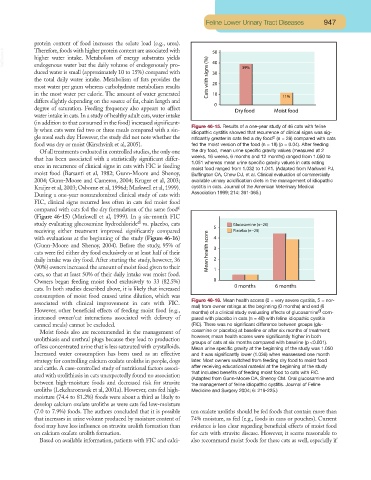Page 915 - Small Animal Clinical Nutrition 5th Edition
P. 915
Feline Lower Urinary Tract Diseases 947
protein content of food increases the solute load (e.g., urea).
VetBooks.ir Therefore, foods with higher protein content are associated with
higher water intake. Metabolism of energy substrates yields
endogenous water but the daily volume of endogenously pro-
duced water is small (approximately 10 to 15%) compared with
the total daily water intake. Metabolism of fats provides the
most water per gram whereas carbohydrate metabolism results
in the most water per calorie. The amount of water generated
differs slightly depending on the source of fat, chain length and
degree of saturation. Feeding frequency also appears to affect
water intake in cats. In a study of healthy adult cats, water intake
(in addition to that consumed in the food) increased significant-
Figure 46-15. Results of a one-year study of 46 cats with feline
ly when cats were fed two or three meals compared with a sin-
idiopathic cystitis showed that recurrence of clinical signs was sig-
c
gle meal each day. However, the study did not note whether the nificantly greater in cats fed a dry food (n = 28) compared with cats
food was dry or moist (Kirschvink et al, 2005). fed the moist version of the food (n = 18) (p = 0.04). After feeding
Of all treatments evaluated in controlled studies, the only one the dry food, mean urine specific gravity values (measured at 2
that has been associated with a statistically significant differ- weeks, 16 weeks, 6 months and 12 months) ranged from 1.050 to
1.051 whereas mean urine specific gravity values in cats eating
ence in recurrence of clinical signs in cats with FIC is feeding
moist food ranged from 1.032 to 1.041. (Adapted from Markwell PJ,
moist food (Barsanti et al, 1982; Gunn-Moore and Shenoy, Buffington CA, Chew DJ, et al. Clinical evaluation of commercially
2004; Gunn-Moore and Cameron, 2004; Kruger et al, 2003; available urinary acidification diets in the management of idiopathic
Kraijer et al, 2003; Osborne et al, 1996d; Markwell et al, 1999). cystitis in cats. Journal of the American Veterinary Medical
During a one-year nonrandomized clinical study of cats with Association 1999; 214: 361-365.)
FIC, clinical signs recurred less often in cats fed moist food
compared with cats fed the dry formulation of the same food c
(Figure 46-15) (Markwell et al, 1999). In a six-month FIC
d
study evaluating glucosamine hydrochloride vs. placebo, cats
receiving either treatment improved significantly compared
with evaluations at the beginning of the study (Figure 46-16)
(Gunn-Moore and Shenoy, 2004). Before the study, 95% of
cats were fed either dry food exclusively or at least half of their
daily intake was dry food. After starting the study, however, 36
(90%) owners increased the amount of moist food given to their
cats, so that at least 50% of their daily intake was moist food.
Owners began feeding moist food exclusively to 33 (82.5%)
cats. In both studies described above, it is likely that increased
consumption of moist food caused urine dilution, which was
Figure 46-16. Mean health scores (0 = very severe cystitis, 5 = nor-
associated with clinical improvement in cats with FIC.
mal) from owner ratings at the beginning (0 months) and end (6
However, other beneficial effects of feeding moist food (e.g., months) of a clinical study evaluating effects of glucosamine com-
d
increased owner/cat interactions associated with delivery of pared with placebo in cats (n = 40) with feline idiopathic cystitis
canned meals) cannot be excluded. (FIC). There was no significant difference between groups (glu-
Moist foods also are recommended in the management of cosamine or placebo) at baseline or after six months of treatment;
however, mean health scores were significantly higher in both
urolithiasis and urethral plugs because they lead to production
groups of cats at six months compared with baseline (p <0.001).
of less concentrated urine that is less saturated with crystalloids. Mean urine specific gravity at the beginning of the study was 1.050
Increased water consumption has been used as an effective and it was significantly lower (1.036) when reassessed one month
strategy for controlling calcium oxalate uroliths in people, dogs later. Most owners switched from feeding dry food to moist food
and cattle. A case-controlled study of nutritional factors associ- after receiving educational material at the beginning of the study
that included benefits of feeding moist food to cats with FIC.
ated with urolithiasis in cats unexpectedly found no association
(Adapted from Gunn-Moore DA, Shenoy CM. Oral glucosamine and
between high-moisture foods and decreased risk for struvite the management of feline idiopathic cystitis. Journal of Feline
uroliths (Lekcharoensuk et al, 2001a). However, cats fed high- Medicine and Surgery 2004; 6: 219-225.)
moisture (74.4 to 81.2%) foods were about a third as likely to
develop calcium oxalate uroliths as were cats fed low-moisture
(7.0 to 7.9%) foods. The authors concluded that it is possible um oxalate uroliths should be fed foods that contain more than
that increases in urine volume produced by moisture content of 74% moisture, as fed (e.g., foods in cans or pouches). Current
food may have less influence on struvite urolith formation than evidence is less clear regarding beneficial effects of moist food
on calcium oxalate urolith formation. for cats with struvite disease. However, it seems reasonable to
Based on available information, patients with FIC and calci- also recommend moist foods for these cats as well, especially if

